
We at Lovinger Robertson Landscape Architects recently attended a wonderfully useful lecture organized and sponsored by the Willamette Valley chapter of the American Society of Landscape Architects (ASLA). Michel Wiman of Earthfort shared enlightening information, and in turn we thought we would share some highlights with our readers and followers.
First, we must point out that the scientific community is always learning more about the organisms that participate in the soil food web. However, we can apply what knowledge we do have to approach soil management biologically rather than chemically. Soil is absolutely teeming with living things. We can generally break up the organisms into three groups: macrofauna, which include animals like centipedes, voles, earthworms, and snails, mesofauna, which include microscopic worms called nematodes, protozoa, and pathogens, and microorganisms, which include bacteria and fungi. Realizing that soil is anything but a sterile environment should also help us to realize that gardening is a cooperative process.
For example, did you know that the relative proportion of fungi to bacteria affects the pH of soil? Tilling the soil your planting beds sets the soil to a bacterially dominated and alkaline habitat, which favors early successional plants, being primarily what we consider “weeds.” Trees, shrubs and later successional perennials, the kinds of plants we typically want to thrive in our gardens, prefer the acidic environments of fungi dominated soils. The presence of fungi encourages mycorrhizal associations, which are critical to the function of a plant’s nutrient uptake. If we break up the word “mycorrhiza” into its constitutive parts – “myco” meaning fungus and “rhiza” meaning root – it is easier to remember that a mycorrhizal association is simply a mutually beneficial relationship formed by a fungus and a plant. Mycorrhizal filament growth allow plants to reach beyond their root depletion zone, accessing nutrients that would otherwise be beyond reach.

This example illustrates that the flora and fauna living of the soil have specific roles in the health of that soil. Protozoa help to decompose organic material, earthworms aerate the soil, and predatory nematodes kill pest insects. Which leads us to the idea of integrated pest management (IPM). IPM favors biological based intervention over chemical control. Chemical approaches to controlling pests create vacuums in nature. Spraying to eradicate a species of pest insect may successfully eradicate most of the individual pests. However, those that are resistant to the control will quickly reproduce to take advantage of the biological vacuum, therefore rendering the chemical control useless. IPM advocates management to eliminate vacuums. It looks to suppress pests by targeting sensitive stages of the pest’s life cycle, thereby reducing populations to a level that does not cause harmful effects. The crux of IPM is being in touch with what’s happening in your soil. Monitoring and identifying pest activity is crucial, and it does involve additional time and effort.
We think that this base knowledge of the inner workings of living soil has a cascading effect how we view and interact with our gardens. Of course, there is always more to learn and the folks at Earthfort are an incredible resource. Additionally, if you want to learn more from home, the UC Davis IPM website is a great place to start.